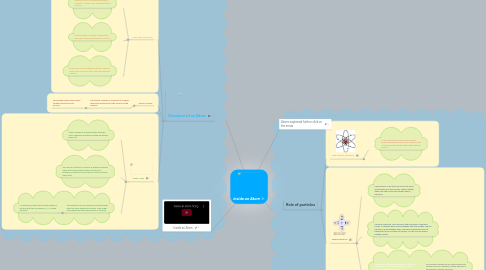
1. Structure of an Atom
1.1. Three kinds of particles
1.1.1. Protons is one of the three.They have a positive(+) charge. They are attractted to neutrons
1.1.2. Neutrons have no charge. Meaning the are nuetral. They are atrracted to protons.
1.1.3. Elctrons are a very energetic particles. They go around the nucleus in rings. They are negatively charged.
1.2. Atomic Number
1.2.1. The Atomic Number of a element is to show how many protons are in the nucleus of the element.
1.2.1.1. For Example every carbon atom contains 6 protons in its nucleus.
1.3. Atomic Mass
1.3.1. Atoms cannot be measured with everyday units. Therefore scientists created the atomic mass unit.
1.3.2. The mass of a proton or neutron is about one atomic mass unit.An atom that contains 6 protons, 6 neutrons, 6 electrons has a mass of about 12 atomic mass units.
1.3.3. Altough atoms of any particular element always have the same number of protons. They might not always have the same number of neutons.
1.3.3.1. For Example Carbon atoms always have six protons,But they may have,5 ,6 ,7 ,or eight neutrons.
2. Inside an Atom
3. Role of particles
3.1. Little Particles, Big spaces
3.1.1. Most of an atom's mass comes from the neutons and protons. But most of the volume comes from the space in which the electrons move in.
3.2. Valence Electrons
3.2.1. The electrons in an atom are not all the same space away from the nucleus. Those furthest away from the nucleus are called valence electrons.
3.2.2. Valnence electrons, are involved in the formation of chemical bonds. A chemical bond forms between two atoms when valence electrons move between them. The valence electrons may be transferred from one atom to another, or they may be shared between atoms.
3.2.3. The number of valance electrons in an atom can range from 1 to 8. Each element has a typical number of valence electrons.
3.2.3.1. For example Oxygen has six valence electrons, carbon has four, Hydrogen's single electron is considered a valence electrons

